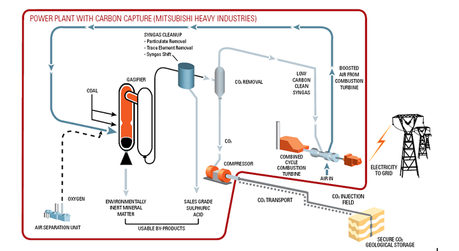
Illustration of the Carbon Capture Technology
Carbon capture and storage (CCS) will need to play a substantial role in mitigating global emissions alongside measures such as renewable energy and energy efficiency.
But can this technology help us reach climate targets?
The International Institute for Applied Systems Analysis reports in a study:
The future availability of carbon capture and storage (CCS) will be pivotal in reaching ambitious climate targets, according to a new comprehensive study of future energy technologies from IIASA, the Potsdam Institute for Climate Change, the Stanford Energy Modeling Forum, and researchers worldwide.
The study, published in a special issue of the journal Climatic Change, provides an overview of the results of EMF27, a major research project combining 18 different global energy-economy models from research teams around the world. It examines the role of technology in future climate mitigation, asking which technologies will be needed and when in order to reach different climate targets.
In 2010, coal, oil, and gas supplied more than 80% of the world’s total primary energy supply—and the demand for energy is projected to increase by 2 to 3 times by 2100. The EMF27 study shows that without policies to cut greenhouse gas emissions, fossil fuels will remain the major energy source in 2100, with resulting increases in greenhouse gas emissions. But where should policymakers focus their carbon mitigation efforts? Which technologies hold the most promise?
“Some technologies are more valuable than others, particularly CCS and bioenergy compared to wind, solar, and nuclear energy, because the combination of the two can lead to negative emissions,” says IIASA researcher Volker Krey, lead author of the study published last week. “That would allow us to compensate for short term delays in mitigation by later taking carbon out of the atmosphere.”
CCS is a yet-unproven technology that would remove carbon from fossil fuel or bioenergy combustion and store it underground. In combination with bioenergy, this results in carbon dioxide removal from the atmosphere (owing to the previous carbon uptake of plants through photosynthesis) and is frequently referred to as “negative emissions”. The big questions are whether and when it will become available, and how quickly it could be deployed.
The future availability of bioenergy and CCS technologies would also take some pressure off other sectors, in terms of required mitigation effort, says Krey. “Unless stringent mitigation action in transport and other end-use sectors is implemented almost immediately, the only way to still achieve the 2 degree target will be to rely on carbon dioxide removal technologies such as bioenergy with CCS.”
Bioenergy is an especially valuable energy resource because, unlike solar, wind, and hydro power, it can be converted into liquid and gaseous fuels which are easily storable and can be readily used by current transportation systems, while the other renewable technologies would require electric or hydrogen vehicles and infrastructure in order to power transportation.
Credit:
The International Institute for Applied Systems Analysis is a scientific research institute located in Laxenburg, near Vienna, Austria. Co-Editors of this report M. Oppenheimer, and G. Yohe -- titled 'An Interdisciplinary, International Journal Devoted to the Description, Causes and Implications of Climatic Change'
Story + Publications (1, 2, 3) + Image
